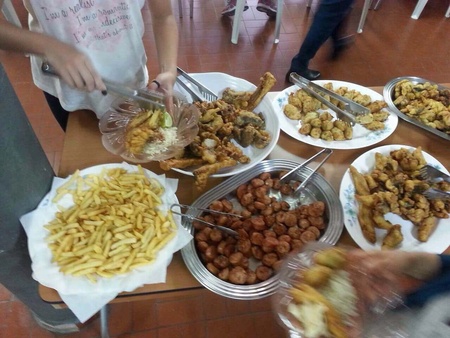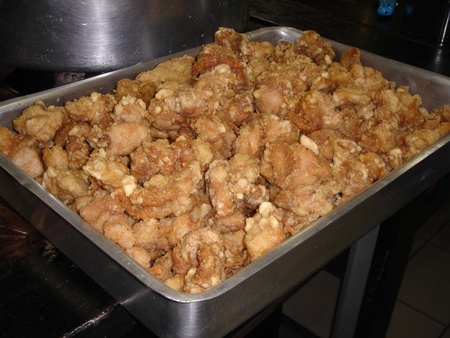Dona Miyoko is my mother, who is currently 93 years old. She was only 29 when my father passed away, leaving her with four small children to raise. At that time, my grandmother encouraged her to open a boarding house, offering bed and board to youths from Japanese families who lived in the interior of São Paulo State and came to the capital to study.
She started out by receiving eight boarders who had come to attend college, providing breakfast, lunch, and dinner—or take-outs for those who stayed out all day.
The boarding house was located in a building on Carlos de Souza Nazareth Street, in the Mercado neighborhood, on the same street as my father’s egg warehouse, which he owned in partnership with my Uncle Hideo.
The meals that Dona Miyoko prepared pleased both the Brazilian and the Japanese palate, so that shortly afterward she became well known in the neighborhood. Local merchants began asking her to serve take-out lunches, and word of mouth led to the gradual increase in business thanks to her affordable prices and the high quality of the meals.
My mother was a pioneer when it came to offering lunch and dinner in the self-service system—and this was over 60 years ago!
Every day, there were three types of rice: shiro-gohan, abura-gohan, and maze-gohan, as well as misoshiru and tsukemono, which are indispensable side dishes on the Japanese table. There were also the very Brazilian black bean, a vegetable mix, Kool-Aid (oh, how I miss it!), and dessert—usually bananas and oranges. The menu changed according to the day of the week. So, on Monday there was steak and fried egg; on Tuesday, tripe stew; on Wednesday, feijoada [black-bean-based stew]; on Thursday, macarronada [spaghetti with Parmesan cheese, sauce, and oftentimes some kind of meat]; on Friday, fish. On Saturday, there was a varied menu, and on Sunday there was a special with lasagna, codfish, and a special dessert.
How did Dona Miyoko learn to be a good cook? Did that happen in Japan or in Brazil?
My grandfather, Sadakichi Kawauchi, married Kuri, with whom he had four children, and the family lived in Osaka. As he was a high official of the national railroad, they enjoyed a good standard of living and led a comfortable life. Unlike many housewives back then and nowadays, my grandmother didn’t need to cook. All she did was prepare the gohan and the misoshiru, as she bought all the other dishes ready-made, for in those days Osaka was already quite well developed. But one day, they left for Brazil and, as immigrants, had to work in the fields, growing and harvesting coffee and cotton in the state of São Paulo.
My grandmother had to work with her husband in the fields, so the difficult task of cooking for the family was left to the 8-year-old girl Miyoko. She had to use a lot of creativity to prepare the food with the few available resources, but she took pleasure doing it, remembering everything she had eaten while living in Japan.
Later on, she went to Professor Michie Akama’s girls’ school on Vergueiro Street, where she learned the art of cooking. Yet I do believe that all her culinary knowledge stems from the practice she got since her days as a young girl cooking for the family.
My brother Luiz, my sisters Amália and Noemia, and myself didn’t help my mother at the boarding house, as we all started working very early. But whenever my mother fell ill or had to step out with the younger daughters, Luiz, being the oldest, from the age of 5 or 6 was able to make rice and mix it with the vegetables he would gather from the backyard garden.
This early learning made him, Dona Miyoko’s only son, the master chef at family gatherings, when he prepared sukiyaki and other dishes very well.
Currently, Luiz and his friend Nelson Kashiwakura head the kitchen staff at events organized by their church at least twice a month. One of these events is called Niji-no-kai, where the guests are Nikkei ladies and gentlemen eagerly awaiting the serving of gochiso. For these occasions, Luiz and Nelson prepare the menu well in advance, exchanging ideas and doing research on the Internet, to the point that their wives are amazed to see how these two grown men act like kids, with so much enthusiasm and the desire to do their very best—whatever it takes to please the palates of their guests.
They’ve recently prepared the following menu: kara-age, maabo nasu, maze-gohan, and a salad with a special miso sauce that was a hit! So much so that this menu will be repeated at another event in October.
Regarding the kara-age, the traditional, Japanese-style fried chicken, Luiz and Nelson gave it a Brazilian touch by making use of a technique practiced by fishermen, which works as follows: before frying, soak in cold water each slice of chicken breaded with cornstarch; then, immediately put it in the frying pan with sizzling hot oil. That makes the chicken really crispy and it’s a treat to be enjoyed by everyone!
These days, my mother lives in a nursing home, where she performs many activities—her favorite is eating. She has managed to pass on her talent and love of cooking to my brother Luiz, and I’m very happy about it.
© 2017 Iraci Megumi Nagoshi








